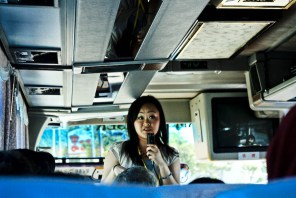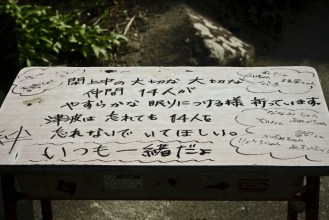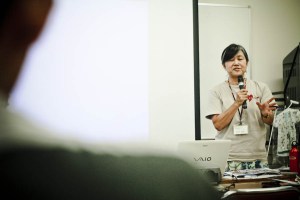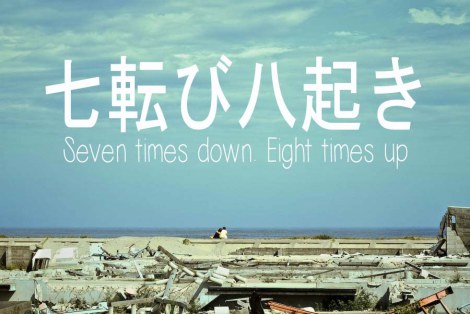By Ita Pravitasari
Pravitasari is a senior student in Universitas Indonesia. Besides her major is psychology, she also spend her enthusiasm in another fields that excite and challenge such as philosophy, women's issues, child protection, disaster education, and youth's issues. Feel free to share your views about anything with her: [email protected]
On this second memorial of the Great East Japan Earthquake 3/11, I would like to share my experiences when I visited Sendai city last summer. I had opportunity to hear stories directly from the survivors and their families about what happened during and after the tsunami struck Sendai. I also had opportunity to see the area that was destroyed by the tsunami. There are stories about grief, loss, and resurrection. Those are the stories behind debrises that I had seen there.
Pravitasari is a senior student in Universitas Indonesia. Besides her major is psychology, she also spend her enthusiasm in another fields that excite and challenge such as philosophy, women's issues, child protection, disaster education, and youth's issues. Feel free to share your views about anything with her: [email protected]
On this second memorial of the Great East Japan Earthquake 3/11, I would like to share my experiences when I visited Sendai city last summer. I had opportunity to hear stories directly from the survivors and their families about what happened during and after the tsunami struck Sendai. I also had opportunity to see the area that was destroyed by the tsunami. There are stories about grief, loss, and resurrection. Those are the stories behind debrises that I had seen there.
Junko’s Story
When the tsunami struck, Junko was in the office which is located quite far from the coast. However, her mother lived in a location that quite close to the beach so that even if she survived, she was very concerned about her mom’s condition. Shortly after she allowed to visit the area where her mother lives, she rushed to go there. When she got to the location where her home was, Junko saw her house was destroyed and she couldn’t find her mother there. Then from that day until a few days after, she traveled from one shelter to another shelter to look for her mother. She had doubts about whether her mom still alive or not. Fortunately, Junko finally able to find her mother in one of the shelters. Her mother told Junko that once she received a tsunami warning, she immediately rushed to the car and drive away from the house. Interestingly, after having met Junko, her mother told Junko to not be worrying about her and asked Junko to return to workplace because Junko works on the support center for foreign nationals who offers support and promotion to Miyagi citizens that are internationally active. Her mother consider that Junko must be able to also help foreign nationals who may be experiencing some difficulties after the tsunami hit.
Even so, not only sadness that was behind the ruins of the buildings in Sendai, but also amazing stories about how the Japanese remain civilized despite of they’re being in the midst of difficulties. The story about the survivors that queue orderly while receiving aid already reported a lot. But, I had never heard of this story that was told by Junko and for me this story was very evocative. Shortly after the tsunami struck, the survivors need foods and clean waters. At that time, many kombini or convenience stores like lawson, family mart, and 711 opened their warehouse and invited the survivors to pick up foods and drinks for free. Interestingly, a few months after the incident, many survivors returned to those kombini to pay for foods and drinks that they had taken though the kombini had confirmed that those foods and drinks was provided free of charge.
Even so, not only sadness that was behind the ruins of the buildings in Sendai, but also amazing stories about how the Japanese remain civilized despite of they’re being in the midst of difficulties. The story about the survivors that queue orderly while receiving aid already reported a lot. But, I had never heard of this story that was told by Junko and for me this story was very evocative. Shortly after the tsunami struck, the survivors need foods and clean waters. At that time, many kombini or convenience stores like lawson, family mart, and 711 opened their warehouse and invited the survivors to pick up foods and drinks for free. Interestingly, a few months after the incident, many survivors returned to those kombini to pay for foods and drinks that they had taken though the kombini had confirmed that those foods and drinks was provided free of charge.
Story from Yuriage JHS
Like I said before, I also had time to see the area that was affected by very severe damages, including Yuriage secondary schools. At the front of the school, there was a table that contains text “maybe we can forget the tsunami, but we will not forget our 14 friends (who became victims in this incident).” This made me realize that disasters may cause psychological problems and this sense was confirmed also by Mrs Iizawa, a member of Tomodachi in Natori International Association, a volunteer group that involved in the provision of psychosocial support for the survivors.
Mrs. IIZAWA Hiromi’s Story
Stories that was told by Mrs Iizawa are about how she and her colleagues from Tomodachi in Natori International Association providing psychosocial support to the survivors for several months. They’re living with the survivors as well as to provide support for them and that’s not an easy thing to do. Challenges that were faced by them are from rejected by the survivors to dealing with survivors who have lost their enthusiasm for life. They hold a variety of activities for the survivors such as the tea ceremony, musical performances, dance course, etc that are considered to enhance survivor’s passion to live
In the end, I want to stated that behind the debrises in Sendai, stored a variety of stories. until now, from the news I read on the internet, the stories still exist. a story about loss, about healing efforts, and another stories which show to us that after the disaster struck, not only the buildings that collapsed but also the survivors. That’s why we need to build disaster resilience and I cite Mr. President’s remarks who said that disaster resilience should be made as one of the national building blocks for sustained prosperity.
you can also access this writing at http://itapravita.wordpress.com/2013/03/10/311-the-stories-behind-debrises/
you can also access this writing at http://itapravita.wordpress.com/2013/03/10/311-the-stories-behind-debrises/




 RSS Feed
RSS Feed